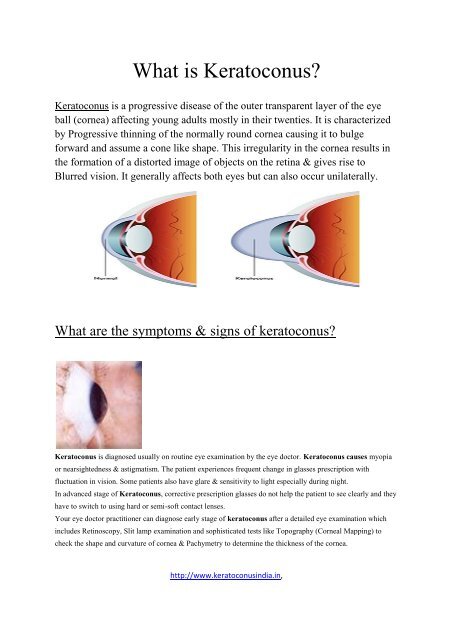What is keratoconus - Ojaseyehospital
Keratoconus is a progressive disease of the outer transparent layer of the eye ball (cornea) affecting young adults mostly in their twenties. It is characterized by Progressive thinning of the normally round cornea causing it to bulge forward and assume a cone like shape. This irregularity in the cornea results in the formation of a distorted image of objects on the retina & gives rise to Blurred vision. It generally affects both eyes but can also occur unilaterally.
Keratoconus is a progressive disease of the outer transparent layer of the eye ball (cornea) affecting young adults mostly in their twenties. It is characterized by Progressive thinning of the normally round cornea causing it to bulge forward and assume a cone like shape. This irregularity in the cornea results in the formation of a distorted image of objects on the retina & gives rise to Blurred vision. It generally affects both eyes but can also occur unilaterally.
Create successful ePaper yourself
Turn your PDF publications into a flip-book with our unique Google optimized e-Paper software.
<strong>What</strong> <strong>is</strong> Keratoconus?<br />
Keratoconus <strong>is</strong> a progressive d<strong>is</strong>ease of the outer transparent layer of the eye<br />
ball (cornea) affecting young adults mostly in their twenties. It <strong>is</strong> characterized<br />
by Progressive thinning of the normally round cornea causing it to bulge<br />
forward and assume a cone like shape. Th<strong>is</strong> irregularity in the cornea results in<br />
the formation of a d<strong>is</strong>torted image of objects on the retina & gives r<strong>is</strong>e to<br />
Blurred v<strong>is</strong>ion. It generally affects both eyes but can also occur unilaterally.<br />
<strong>What</strong> are the symptoms & signs of <strong>keratoconus</strong>?<br />
Keratoconus <strong>is</strong> diagnosed usually on routine eye examination by the eye doctor. Keratoconus causes myopia<br />
or nearsightedness & astigmat<strong>is</strong>m. The patient experiences frequent change in glasses prescription with<br />
fluctuation in v<strong>is</strong>ion. Some patients also have glare & sensitivity to light especially during night.<br />
In advanced stage of Keratoconus, corrective prescription glasses do not help the patient to see clearly and they<br />
have to switch to using hard or semi-soft contact lenses.<br />
Your eye doctor practitioner can diagnose early stage of <strong>keratoconus</strong> after a detailed eye examination which<br />
includes Retinoscopy, Slit lamp examination and soph<strong>is</strong>ticated tests like Topography (Corneal Mapping) to<br />
check the shape and curvature of cornea & Pachymetry to determine the thickness of the cornea.<br />
http://www.<strong>keratoconus</strong>india.in,
Suspect Keratoconus when:<br />
• A late teen or young adult myope <strong>is</strong> no longer correctable to 20 / 20 at the phoropter<br />
• There <strong>is</strong> a change in astigmat<strong>is</strong>m. (cylindrical power)<br />
• There <strong>is</strong> a change in ax<strong>is</strong> of astigmat<strong>is</strong>m.<br />
• Frequent change in eye glass power.<br />
<strong>What</strong> causes Keratoconus?<br />
The exact cause of <strong>keratoconus</strong> <strong>is</strong> not known but latest research suggests that the cornea becomes weakened<br />
due to an imbalance of enzymes within the corneal t<strong>is</strong>sue. Young patients produce high level of free radicals<br />
which cause oxidative damage to the cornea in absence of protective enzymes. Th<strong>is</strong> causes thinning and bulging<br />
of the cornea.<br />
Keratoconus also shows some genetic pred<strong>is</strong>position. It may transmit from parent to children and affect more<br />
than one family member.<br />
The Integrity and shape of the cornea are maintained by small protein fibers know as Collagen, which are<br />
extremely robust proteins which are d<strong>is</strong>tributed throughout the body and help in maintaining its structure. When<br />
these collagen fibers in the cornea become friable and damaged the cornea fails to maintain its shape and<br />
therefore cones outward.
Corneal damage occurs due to the formation of free radicals which damage the collagen architecture. Free<br />
radicals are by-products of the functioning cells and they cornea <strong>is</strong> abundant in Mitochondria, which are the<br />
powerhouses of cells. During the production of energy for cells free radicals are formed which are neutralized<br />
antioxidant substances in the body, yet if there <strong>is</strong> a deficiency in antioxidants which may be due to reduced<br />
production within the body or reduced intake by means of antioxidant rich food, will lead to free radical damage<br />
to the cornea amongst other body structures.<br />
Keratoconus can be an acquired condition but an entity known as Familial Keratoconus has been described in<br />
literature in which it states that certain individuals with a significant family h<strong>is</strong>tory of <strong>keratoconus</strong> in direct<br />
relatives have a greater r<strong>is</strong>k of developing the same condition. Since <strong>keratoconus</strong> <strong>is</strong> a very slow progressing<br />
condition which in some cases do not lead to significant comprom<strong>is</strong>ing of sight most individuals are<br />
undiagnosed in the population.<br />
Irritation of the outer aspects of the eye <strong>is</strong> one of the causes of <strong>keratoconus</strong>. The conjunctivae which are the<br />
outer linings of the eye lids are prone to become infected. A commonly known d<strong>is</strong>ease entity known as<br />
Conjunctivit<strong>is</strong> where there <strong>is</strong> reddening, inflammation and irritation of these outer covering of the eyelids causes<br />
itchy eyes in most individuals. Also any foreign objects such as hairs or dust particles or some cosmetic<br />
products can also cause irritation of the eye. Irritant eyes become progressively itchy and due to th<strong>is</strong> there <strong>is</strong><br />
friction damage to the sclera and cornea.<br />
Ultraviolet light poses a great danger to the cornea and the lens of the eyes. The most potent source of natural<br />
Ultraviolet light <strong>is</strong> sunlight and individuals who have prolonged exposure to sunlight such as police officers,<br />
construction workers and members of the armed forces have a significantly high r<strong>is</strong>k of catastrophic damage to<br />
the cornea.<br />
Another source of irritation of the cornea <strong>is</strong> the use of loose fitting incorrectly positions inferior quality contact<br />
lenses, some of which are sold over the counter for cosmetic purposes. These cause irritation of the conjunctivae<br />
and eye which in turn leads to the attraction of infections to the eye which will damage the cornea.



